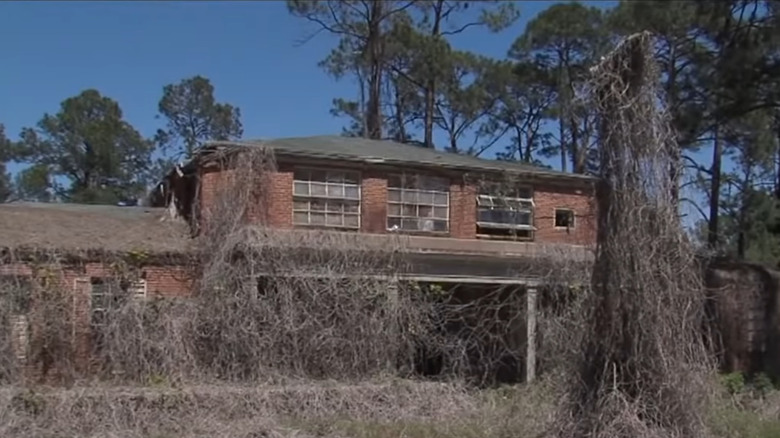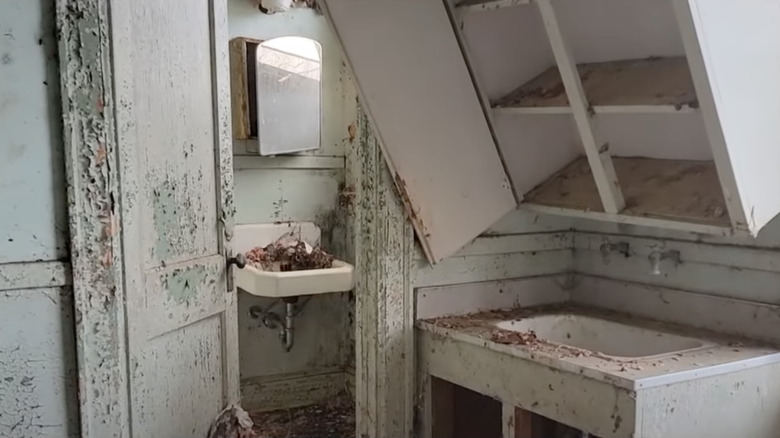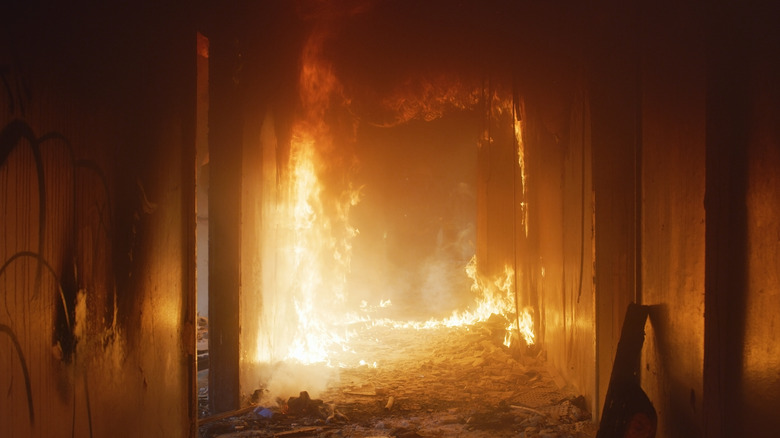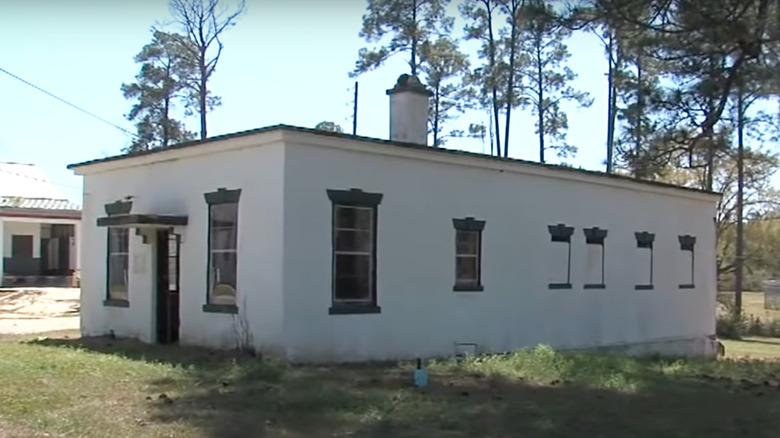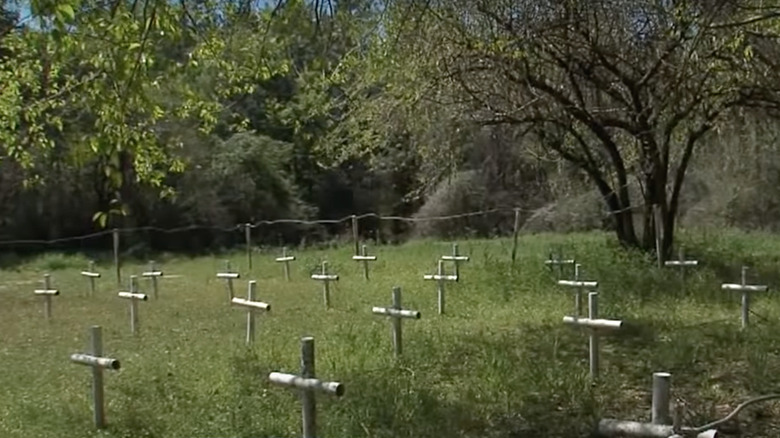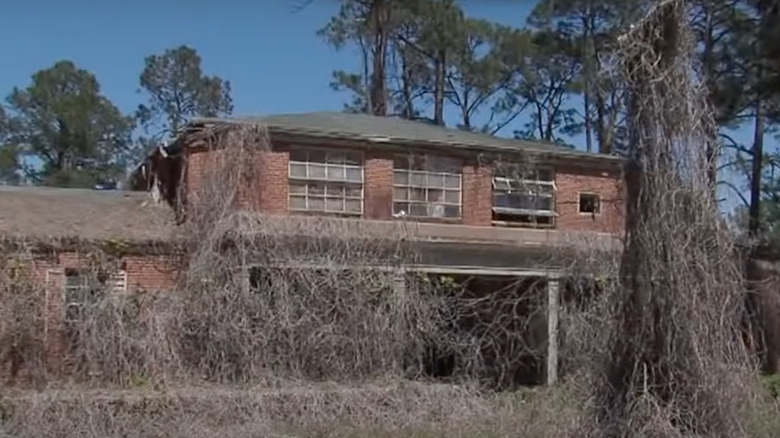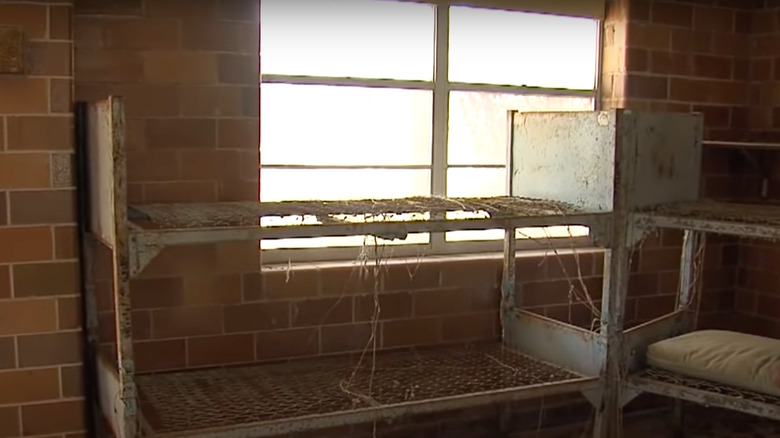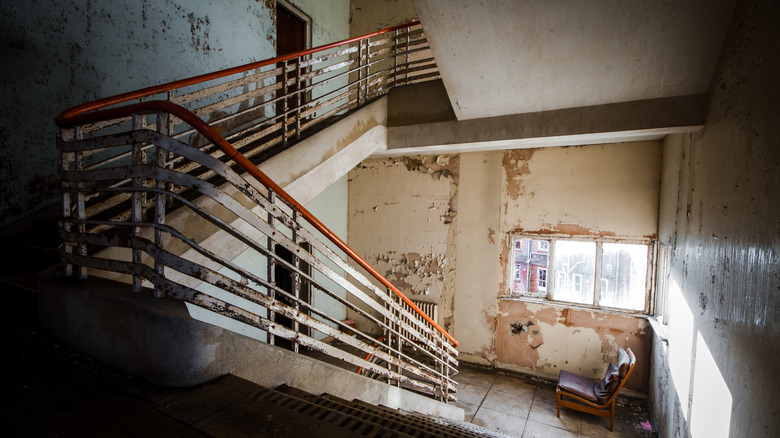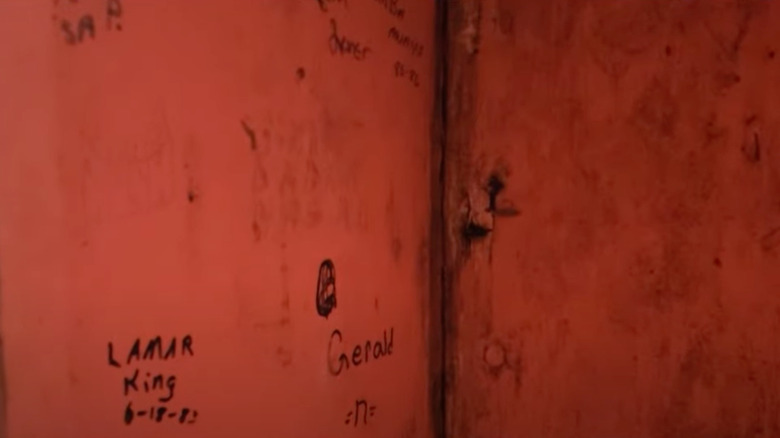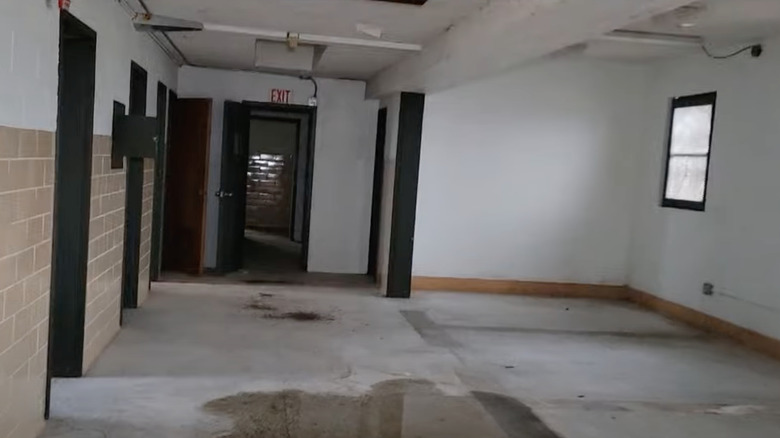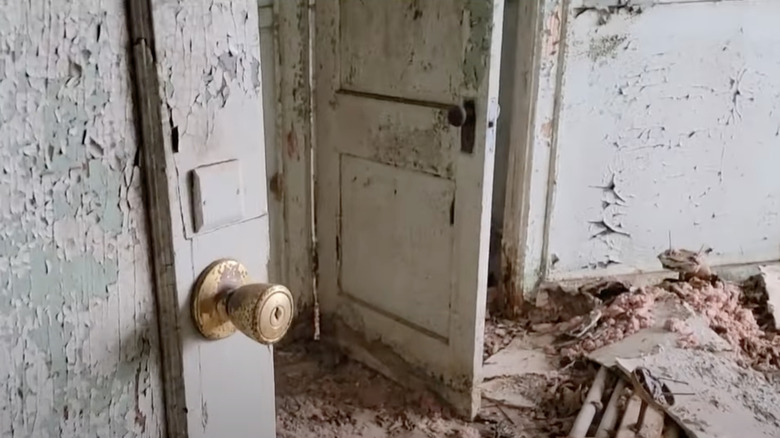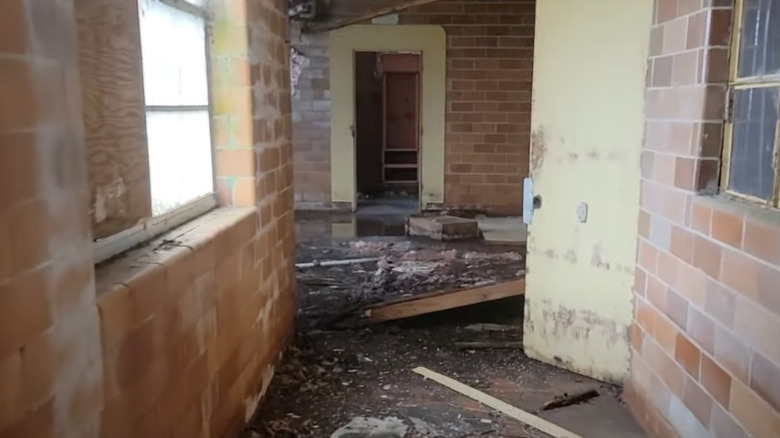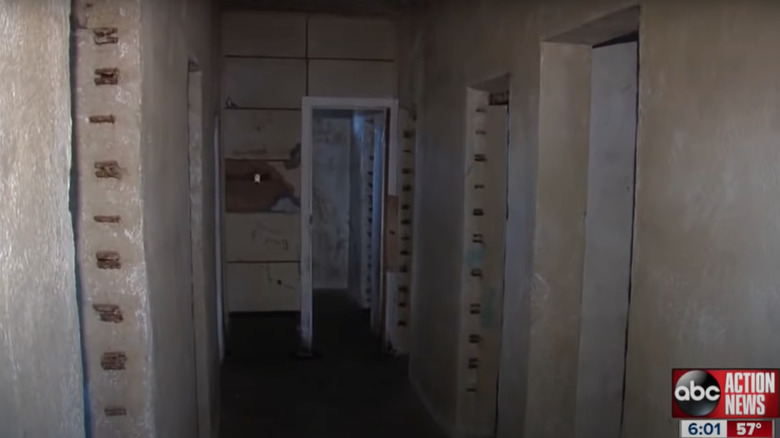The Horrifying History Of The Florida School For Boys
The following article includes allegations of violence and child abuse.
There are no words to describe what happened behind the Florida School for Boys' closed doors for over a century. Like St. Petersburg Times reports, the men who passed through the infamous reform school might have been there for just a few years, but the scars they were left with were lifelong: PTSD, prison, failed relationships, and ongoing battles with anger and addiction.
You might be excused for thinking the Florida School for Boys started off as a tough place with strict rules and became more relaxed after World War II — perhaps a devastating global war is what it took to reveal the value of peace. But it was precisely after the war that conditions got even harsher for the boys aged 5-20, confined within the tiny, filthy spaces of the school. The Florida School for Boys — or the Arthur G. Dozier School for Boys — in Marianna is a century-long tragic story and a cautionary tale about ignored red flags and grave misconduct. Here's the horrifying history of the Florida School for Boys.
The first red flags came very early on
The Florida State Reform School opened its doors at the turn of the 20th century — exactly on January 1, 1900, as per The Washington Post. A beautiful date like this might inspire the idea of new beginnings, but that was never the case with the Florida School for Boys. Within the first years of its opening, uncanny reports started piling up. As per St. Petersburg Times, a group of investigators was shocked to find children in iron shackles as early as 1903. It's worth noting that this was a reform school, not a prison — many of the boys had been sent here because they'd been caught smoking or skipping school. Others had run away from broken homes, like Robert Straley told Dee Dee Sharp on "Aware!"
In 1912, the Jacksonville Metropolis sent out the first big red flag concerning the Florida School for Boys. The report said: "[The superintendent was] in the habit of brutally beating his charges ... there is no adequate place to care for the sick ... [and there are] insufficient food and unsanitary conditions." The report also revealed that the school was segregated by race, and "in the negro school, conditions are shown to be heartrending." This was known back in 1912. Why did it take another century for the school to close?
The 1914 fire
One of the most horrific incidents at the Florida School for Boys happened on the morning of November 18, 1914, as per this University of South Florida report. The south campus dormitory caught fire, and somewhere between eight and 10 people died (two staff members and several boys). As The Washington Post reports, the fire was deemed accidental, but there were several grave misconduct issues here. On the one hand, the dormitory's fire escapes were blocked, according to some press releases. On the other hand, when a grand jury investigated the fire, it was revealed that the school's superintendent and school staff were out for drinks (via the St. Petersburg Times). The superintendent lost his job that year, but it was one minute too late.
The Pensacola Journal shared the true horror of the fire: "Of most of the bodies nothing remained but charred lumps of flesh and bone representing the bodies and organs that had been roast to an unrecognizable blackened mass. Two of the larger ones, however, retain the shape of the human body with all the vital organs exposed. In none was there the slightest semblance of a possibility of recognition ... The entire city and country are horrified at the terrible disaster, which is perhaps the worst of its kind in the history of the state."
The White House
The Florida School for Boys wasn't just a place ridden with sloppy accidents and careless staff. The staff often proved cruel, with stories of torture, rape, and mysterious deaths flooding the media in the 21st century, as WSRE PBS reports. The most vocal group of men who spoke about their traumatizing time at the reform school called themselves the "White House Boys." These were men that were at the school during the 1950s and 1960s, arguably the institution's most violent decades.
The White House Boys named their group after the White House, a small shack on the school's compound where boys would get taken to be punished. Jerry Cooper, a White House Boy, commented (via NPR): "These were not spankings. These were beatings, brutal beatings ... And every time that strap would come down, you could hear the shuffle on the concrete because their shoes would slide." Indeed, as the St. Petersburg Times also reports, the Florida School for Boys' staff claimed they would spank the boys when they would in fact flog them brutally until flesh came off their behinds. The exposé shares some telling pictures of the survivors and of the bloody walls they left behind.
The routine went as follows: the staff members would tell the boys to lay down on the dirty beds, hold on tightly to the railing, and bite into the pillow. If they screamed, they would get beaten even harder.
If you or someone you know may be the victim of child abuse, please contact the Childhelp National Child Abuse Hotline at 1-800-4-A-Child (1-800-422-4453) or contact their live chat services.
At least 81 boys died at the school
As NPR reports, at least 81 boys died at the Florida School for Boys, and just a handful of deaths are accounted for. This University of South Florida report paints an even grimmer picture: there were just under 100 deaths on campus, between 1900 and 1973. Only two of these were staff members — the ones caught in the dormitory fire in 1914. There are 22 cases of deaths with no recorded burial location and several cases of deaths witnessed by other boys that have yet to be linked to a name or a body.
As the St. Petersburg Times reports, there is also a myriad of unmarked graves on the school grounds. Lenox Williams, who was the school's superintendent between 1966 and 1986, worked with a graduate student to identify the boys buried there. They identified 22 of the 31 graves — but what about the other nine? And if there were up to 100 deaths at the Florida School for Boys, what about the dozens of boys whose bodies have never been found?
The University of South Florida report sheds an even more disturbing light on these mysterious deaths: the mortality rates were highest for boys who had attempted escape and those who had only been at the school for less than three months. Sadly, the death records might never be completed — before 1917, the school wasn't required to issue a death certificate, and from 1920-1941, at least 12 students died without being issued a certificate.
They weren't all bad boys
The physical and mental abuse suffered by the boys at the Florida Reform School was not the right punishment even for the toughest offenders. After all, the purpose of a reform school is to rehabilitate a young person. But a sad twist to the story is that most boys at the Florida School for Boys weren't even offenders. As Jerry Cooper told NPR, "A lot of orphans were there that did not have places at times ... They weren't there for any crime whatsoever. But we had many, many boys who was [sic] there for smoking in school, that were incorrigible. We weren't bad kids. We might have needed help in some respect. But that wasn't the place to find it."
Many others came from broken homes. Robert Straley shared his story on the "Aware!" show: "I kept running away from home. My mother was bipolar and very abusive. I was bipolar, and when I hit puberty, somebody had to go, it wasn't going to be her, and I started running away." He was sent to juvenile homes three times, but he kept escaping, so the state sent him to Dozier School for Boys. "I looked around and I was struck by the beauty of the place." The large campus and carefully tended trees made it look like a good place to spend one's teenage years. All the more shocking when he realized what his fate was going to be at the school.
Horrific racist behavior
Per The Washington Post, the Florida School for Boys was racially segregated until 1968, with the African American boys being held in a different part of the campus. They were also subjected to harsher punishments — the 2016 University of South Florida report tells the harrowing story of Earl Wilson, who died in 1944 in a sweat box. He'd been punished for trying to escape the school — all boys were punished for doing so by being flogged inside the White House, but sweat boxes were reserved for African American boys.
Then there's Dick Colon's account, per St. Petersburg Times: "I looked over to my left and one dryer was going. There was a black boy in it." Another former student, Roger Kiser, is certain the boy died (via NPR): "There was the boy I saw who was dead who came out of the dryer."
Charles Anthony Jones, who left the Florida School for Boys in 1988, wrote: "I was abused so bad, I prayed for God to take my life. I was beat with a razor belt so bad, that I was scared to talk, and I was told if I told anybody in my family, that they will kill my family and they would not feed me. Just to think about it, I went weeks without food." Jones' experience happened two decades after the segregation ended at the Florida School for Boys.
If you or someone you know may be the victim of child abuse, please contact the Childhelp National Child Abuse Hotline at 1-800-4-A-Child (1-800-422-4453) or contact their live chat services.
Boys would get lashed until they passed out (and worse)
Jerry Cooper, one of the "White House Boys," remembers his first flogging (via NPR): "The first blow lifted me a foot and a half off that bed." The pain was unbearable, but the staff kept going. Another boy listening from the adjacent room remembers counting 135 lashes. But somewhere along the way, Cooper lost his consciousness. Frank Marx also remembers passing out from the beatings (via St. Petersburg Times). Ed Adams, who died in 2004 after abusing antidepressants and starving himself, also wrote of the flogging days: "And then I remember the sound of something cutting the air, followed by a pain I can't describe. The most horrible pain a human being can imagine ... God, Please make them stop beating me. But they beat me and beat me so bad."
And it could get even worse. Several "White House Boys" confirmed that there were boys who lost their lives inside the White House and that Troy Tidwell, the one-armed man who was responsible for a huge amount of torture, would order other boys to dig boy-sized holes in the ground at night. Then there was also an underground room which the guards called the "rape room." At least three of the "White House Boys" have memories from that room.
If you or someone you know may be the victim of child abuse, please contact the Childhelp National Child Abuse Hotline at 1-800-4-A-Child (1-800-422-4453) or contact their live chat services.
If you or anyone you know has been a victim of sexual assault, help is available. Visit the Rape, Abuse & Incest National Network website or contact RAINN's National Helpline at 1-800-656-HOPE (4673).
Most of the men now struggle with PTSD
Not all the boys at the Florida School for Boys were confined to its walls for a long time. As St. Petersburg Times reports, Marshall Drawdy was at the school for a mere 17 months, after being caught throwing a bicycle into a gutter. Nevertheless, the scars left by the staff are very deep: "The whole place was just a damn hellhole and I can't forget it. They need to be in hell." The trauma didn't go away for these men, and they dealt with anger and violent tendencies that affected others, too. Leon Holston and Donn Duncan are serving life imprisonment sentences for murder, while Roger Lee Cherry and Robert Hendrix are on death row for the same reason.
Many former Florida School boys have learned to disdain authority at the school and went on to pursue a life of petty crime. Others have various forms of PTSD that follow them to this day. Roger Kiser describes having five failed marriages and serious issues when it comes to physical affection. James Griffin — who was 63 when he spoke to St. Petersburg Times — is afraid to sleep in the dark. Robert Lundy and Michael O'McCarthy said they developed alcohol addictions that cost them relationships and made them paranoid. Sadly, for the many men who spoke about their traumatizing time at the Florida School for Boys, it seems like the pain will never fully leave them.
The staff are trying to cover it up
When the "White House Boys" gathered at the school in 2008, as the St. Petersburg Times reports, they started a lengthy and tiresome process of uncovering all the horrors suffered by the boys — especially those who had attended the school in the 1950s and 1960s. So authorities and journalists started speaking to the staff who was at the school during that time. Former superintendent Lenox Williams claimed he'd never even seen the leather strap so many boys were flogged with (and which left scars some have shown on camera): "We used a paddle. We were supposed to administer it to the buttocks and nowhere else, and we did."
And when St. Petersburg Times tried to speak with Troy Tidwell, the notorious one-armed disciplinarian, his ex-wife told off the journalists: "You're just trying to ruin a good man's life. Leave him alone!" The rest of his family painted him as a good man who never laid a hand on his children. They claim the "White House Boys" are lying. Tidwell died in April 2021, aged 97.
Interestingly enough, Williams was also interviewed by the St. Petersburg Times in 1968 — then, he admitted the school was severely understaffed and commented: "I know some children are harmed by their experience here, but what can we do?" Although several things could have been done to cap the population and reduce the severity of the punishments, little efforts have been made by Williams or later superintendents.
Children saw each other die from torture
Roger Kiser, the "White House Boys" founder, wrote on his website: "There were many nights when young boys were taken from their cottages screaming and crying and were raped by the staff. Many of these boys never returned to their cottages and were never heard from again ... Some were as young as five." As a student there, Kiser also heard rumors of bodies being incinerated with the daily trash and used as fertilizer.
Boys heard each other scream in agony, until there was silence (indeed, the reason was sometimes a very grim one). But they would also see death. Kiser told NPR: "I know of one that I personally saw die in the bathtub that had been beaten half to death. I thought he'd been mauled by the dogs because I thought he had ran [sic]. I never did find out the true story on that."
Then there was the death of 16-year-old Michael Smelley in 1966, which made the St. Petersburg Times headlines in 2009. Smelley and three other boys attempted to escape the school: They were caught, and they were punished. It's unclear what exactly happened to Smelley inside the White House, but fellow escapee Donnie Schoffner remembers seeing him deteriorating rapidly. After he couldn't walk anymore, he was moved to the infirmary, and soon after, he died.
If you or anyone you know has been a victim of sexual assault, help is available. Visit the Rape, Abuse & Incest National Network website or contact RAINN's National Helpline at 1-800-656-HOPE (4673).
One superintendent normalizes abuse
Lenox Williams started working at the Florida School for Boys as a psychologist back in 1960, as the St. Petersburg Times reports. The school was in dire need of a reform, as there were 140 staff members to over 900 boys, and the overall living conditions were very poor. In 1968, Williams admitted they were overwhelmed: "A youngster can go through here without getting any real attention at all. We are more or less warehousing kids." In 1966, Williams became the school superintendent, and it was under his command that disciplinarians R.W. Hatton and Troy Tidwell administered some of the most brutal punishments that the "White House Boys" describe.
Still, Williams denied children being beaten to death or flogged, claiming the boys would only get spanked with a paddle. Then, he acknowledged there was some abuse, all the while claiming he was unaware of it if there ever was any: "There probably were some abuses. Anytime you've got human beings together, you're going to have people abusing each other." In other words, he claimed there was nothing he could have done as the school's superintendent.
It wasn't a school; it was a torture house
It's difficult to sum up the horrifying experiences that thousands of children endured inside the Florida School for Boys. But one moment in 1978 is pretty telling, per the St. Petersburg Times. When Health and Rehabilitative Services agent and teacher Jack Levine visited the school, he was surprised to see a dark, prison-like facility with metal doors and strong smells, so he asked the guard to see one of the students held in there. He thus met a severely malnourished bald boy shivering on a concrete slab and unaware of how long he'd been inside the cell. The guard told Levine the boy had been there for quite some time, but that he was just being protected from the boys who had sexually assaulted him. The guard also mentioned they'd shaved his head to avoid further hair pulling.
The school didn't see much reform in its latter days, either. 97% of the men detained in 1988 were arrested again. And in 2008, three years before the school was officially closed, 18-year-old Matthew Schroeder was left an inch away from death for 65 days. He suffered from cystic fibrosis and the school knew this, yet they left him untreated in a cell on his own.
Sadly, the Florida School for Boys created deeply-troubled men and paved their way to prison instead of doing exactly the opposite, as per the definition of a reform school.
